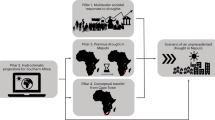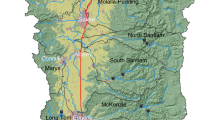Abstract
In water-stressed regions, droughts pose a critical challenge to urban water security for low-income households. Droughts reduce water availability, forcing water providers to invest in additional supplies or enact expensive, short-term emergency measures. These costs are frequently passed on to households through increased rates and surcharges, driving up water bills for low-income households and altering patterns of water consumption. Here we have developed a socio-hydrological modelling approach that integrates hydrology, water infrastructure, utility decision-making and household behaviour to understand the impacts of droughts on household water affordability. We present here an application based on Santa Cruz, California and show that many drought resilience strategies raise water bills for low-income households and lower them for high-income households. We also found that low-income households are most vulnerable to both changing drought characteristics and infrastructure lock-in.
This is a preview of subscription content, access via your institution
Access options
Subscribe to this journal
Receive 12 digital issues and online access to articles
$99.00 per year
only $8.25 per issue
Buy this article
- Purchase on Springer Link
- Instant access to full article PDF
Prices may be subject to local taxes which are calculated during checkout





Similar content being viewed by others
Data availability
All raw data used in this manuscript are freely available: hydrological scenarios derived from California Water Rights Databases62 (https://www.waterboards.ca.gov/waterrights/water_issues/programs/ewrims/), population and demographic data from IPUMS Microdata samples55, infrastructure scenarios from consulting reports45 and Urban Water Management Plans46 (https://wuedata.water.ca.gov/).
Code availability
The relevant code used for water system simulation and bill calculation is available from the corresponding author upon request.
References
Meehan, K. et al. Exposing the myths of household water insecurity in the global north: a critical review. WIREs Water 7, e1486 (2020).
Teodoro, M. P. Measuring household affordability for water and sewer utilities. J. Am. Water Works Assoc. 110, 13–24 (2018).
Teodoro, M. P. & Saywitz, R. R. Water and sewer affordability in the United States: a 2019 update. AWWA Water Sci. 2, e1176 (2020).
Goddard, J. J., Ray, I. & Balazs, C. Water affordability and human right to water implications in California. PLoS ONE 16, e0245237 (2021).
Goddard, J. J., Ray, I. & Balazs, C. How should water affordability be measured in the United States? A critical review. WIREs Water 9, e1573 (2022).
Balazs, C., Goddard, J. J., Chang, C., Zeise, L. & Faust, J. Monitoring the human right to water in California: development and implementation of a framework and data tool. Water Policy 23, 1189–1210 (2021).
Hanak, E. et al. Paying for Water in California 81 (Public Policy Institute of California, 2014).
Howard, G. et al. Domestic Water Quantity, Service Level and Health (WHO, 2020).
Medwid, L. & Mack, E. A. A scenario-based approach for understanding changes in consumer spending behavior in response to rising water bills. Int. Reg. Sci. Rev. 44, 487–514 (2021).
Lund, J., Medellin-Azuara, J., Durand, J. & Stone, K. Lessons from California’s 2012–2016 drought. J. Water Resour. Plan. Manag. 144, 04018067 (2018).
Freire-González, J., Decker, C. & Hall, J. W. The economic impacts of droughts: a framework for analysis. Ecol. Econ. 132, 196–204 (2017).
Caldwell, C. & Characklis, G. W. Impact of contract structure and risk aversion on interutility water transfer agreements. J. Water Resour. Plan. Manag. 140, 100–111 (2014).
Enqvist, J. P. & Ziervogel, G. Water governance and justice in Cape Town: an overview. WIREs Water 6, e1354 (2019).
Janssen, M. A. et al. Toward a network perspective of the study of resilience in social-ecological systems. Ecol. Soc. 11, 15 (2006).
Feinstein, L., Phurisamban, R., Ford, A., Tyler, C. & Crawford, A. Drought and Equity in California (Pacific Institute, 2017).
Cook, J., Brühl, J. & Visser, M. Distributional statistics of municipal water use during Cape Town’s drought: implications for affordability, conservation, and tariffs. Water Resour. Res. 57, e2020WR028219 (2021).
Dalhuisen, J. M., Florax, R. J. G. M., de Groot, H. L. F. M. & Nijkamp, P. Price and Income Elasticities of Residential Water Demand: Why Empirical Estimates Differ Discussion Paper No. 01-057/3 (Tinbergen Institute, 2001); https://www.econstor.eu/handle/10419/86001
Dalhuisen, J. M., Florax, R. J. G. M., de Groot, H. L. F. & Nijkamp, P. Price and income elasticities of residential water demand: a meta-analysis. Land Econ. 79, 292–308 (2003).
Leurig, S. The Ripple Effect: Water Risk in the Municipal Bond Market (Ceres, 2010).
Fielding, K. S., Russell, S., Spinks, A. & Mankad, A. Determinants of household water conservation: the role of demographic, infrastructure, behavior, and psychosocial variables. Water Resour. Res., https://doi.org/10.1029/2012WR012398 (2012).
DeOreo, B. California Single Family Water Use Efficiency Study 371 (California Department of Water Resources, 2011).
Gonzales, P. & Ajami, N. The changing water cycle: impacts of an evolving supply and demand landscape on urban water reliability in the Bay Area. WIREs Water 4, e1240 (2017).
Luthy, R. G., Wolfand, J. M. & Bradshaw, J. L. Urban water revolution: sustainable water futures for California cities. J. Environ. Eng. 146, 04020065 (2020).
Zeff, H. B., Kasprzyk, J. R., Herman, J. D., Reed, P. M. & Characklis, G. W. Navigating financial and supply reliability tradeoffs in regional drought management portfolios. Water Resour. Res. 50, 4906–4923 (2014).
Matikinca, P., Ziervogel, G. & Enqvist, J. P. Drought response impacts on household water use practices in Cape Town, South Africa. Water Policy 22, 483–500 (2020).
Fletcher, S., Strzepek, K., Alsaati, A. & de Weck, O. Learning and flexibility for water supply infrastructure planning under groundwater resource uncertainty. Environ. Res. Lett. 14, 114022 (2019).
Barbour, E. J. et al. Optimisation as a process for understanding and managing river ecosystems. Environ. Model. Softw. 83, 167–178 (2016).
Giuliani, M., Herman, J. D., Castelletti, A. & Reed, P. Many-objective reservoir policy identification and refinement to reduce policy inertia and myopia in water management. Water Resour. Res. 50, 3355–3377 (2014).
Huskova, I., Matrosov, E. S., Harou, J. J., Kasprzyk, J. R. & Lambert, C. Screening robust water infrastructure investments and their trade-offs under global change: a London example. Glob. Environ. Change 41, 216–227 (2016).
Kasprzyk, J. R., Nataraj, S., Reed, P. M. & Lempert, R. J. Many objective robust decision making for complex environmental systems undergoing change. Environ. Model. Softw. 42, 55–71 (2013).
Reed, P. M., Hadka, D., Herman, J. D., Kasprzyk, J. R. & Kollat, J. B. Evolutionary multiobjective optimization in water resources: the past, present, and future. Adv. Water Resour. 51, 438–456 (2013).
Pierce, G., Chow, N., Gmoser-Daskalakis, K., Roquemore, P. & Heil, N., Analyzing Southernn California Supply Investments from a Human Right to Water Perspective (Luskin Center for Innovation, 2019).
Sivapalan, M. et al. Socio-hydrology: use-inspired water sustainability science for the Anthropocene. Earths Future 2, 225–230 (2014).
Di Baldassarre, G. et al. Water shortages worsened by reservoir effects. Nat. Sustain. 1, 617–622 (2018).
Di Baldassarre, G. et al. Sociohydrology: scientific challenges in addressing the sustainable development goals. Water Resour. Res. 55, 6327–6355 (2019).
Elshafei, Y., Sivapalan, M., Tonts, M. & Hipsey, M. R. A prototype framework for models of socio-hydrology: identification of key feedback loops and parameterisation approach. Hydrol. Earth Syst. Sci. 18, 2141–2166 (2014).
Di Baldassarre, G. et al. Socio-hydrology: conceptualising human-flood interactions. Hydrol. Earth Syst. Sci. 17, 3295–3303 (2013).
Ross, A. R. & Chang, H. Modeling the system dynamics of irrigators’ resilience to climate change in a glacier-influenced watershed. Hydrol. Sci. J. 66, 1743–1757 (2021).
Savelli, E., Rusca, M., Cloke, H. & Di Baldassarre, G. Don’t blame the rain: social power and the 2015–2017 drought in Cape Town. J. Hydrol. 594, 125953 (2021).
Pierce, G., El-Khattabi, A. R., Gmoser-Daskalakis, K. & Chow, N. Solutions to the problem of drinking water service affordability: a review of the evidence. WIREs Water 8, e1522 (2021).
Fletcher, S. et al. Equity in water resources planning: a path forward for decision support modelers. J. Water Resour. Plan. Manag. 148, 02522005 (2022).
Thacker, S. et al. Infrastructure for sustainable development. Nat. Sustain. 2, 324–331 (2019).
Boyle, C. E. Adapting to change: water utility financial practices in the early twenty-first century. J. Am. Water Works Assoc. 106, E1–E9 (2014).
Drinking Water—Public Water System Operations Monthly Water Production and Conservation Information—California Open Data (California State Water Resources Control Board); https://data.ca.gov/dataset/drinking-water-public-water-system-operations-monthly-water-production-and-conservation-information
City of Santa Cruz Santa Cruz Regional Recycled Water Facilities Planning Study (Kennedy/Jenks Consultants, 2018); https://www.cityofsantacruz.com/home/showpublisheddocument/71304/636960235723230000
Easley Perez, S. 2020 Urban Water Management Plan (2021).
Brown, T. C. Trends in water market activity and price in the western United States. Water Resour. Res. https://doi.org/10.1029/2005WR004180 (2006).
Zeff, H. B., Herman, J. D., Reed, P. M. & Characklis, G. W. Cooperative drought adaptation: integrating infrastructure development, conservation, and water transfers into adaptive policy pathways. Water Resour. Res. 52, 7327–7346 (2016).
Whittington, D. & Nauges, C. An Assessment of the Widespread Use of Increasing Block Tariffs in the Municipal Water Supply Sector (Global Public Health, Oxford Univ. Press, 2020); https://oxfordre.com/publichealth/view/10.1093/acrefore/9780190632366.001.0001/acrefore-9780190632366-e-243
California Proposition 218. LAO https://lao.ca.gov/1996/120196_prop_218/understanding_prop218_1296.html#appendixII (1996).
Smith, W. J.Jr & Wang, Y.-D. Conservation rates: the best ‘new’ source of urban water during drought. Water Environ. J. 22, 100–116 (2008).
Gaur, S. Policy objectives in designing WATER RATES. J. Am. Water Works Assoc. 99, 112–116 (2007).
Cardoso, D. S. & Wichman, C. J. Water Affordability in the United States Working Paper; 59.
Havranek, T., Irsova, Z. & Vlach, T. Measuring the income elasticity of water demand: the importance of publication and endogeneity biases. Land Econ. 94, 259–283 (2018).
Ruggles, S., King, M. L., Levison, D., McCaa, R. & Sobek, M. IPUMS-International. Hist. Methods 36, 60–65 (2010).
2011–2015 American Community Survey 3-Year Public Use Microdata Samples (US Census Bureau).
Ito, K. Do consumers respond to marginal or average price? Evidence from nonlinear electricity pricing. Am. Econ. Revi. 104, 537–563 (2014).
Wichman, C. J. Perceived price in residential water demand: evidence from a natural experiment. J. Econ. Behav. Organ. 107, 308–323 (2014).
Wichman, C. J., Taylor, L. O. & von Haefen, R. H. Conservation policies: who responds to price and who responds to prescription? J. Environ. Econ. Manag. 79, 114–134 (2016).
El-Khattabi, A. R. et al. Heterogeneous responses to price: evidence from residential water consumers. J. Environ. Econ. Manag. 107, 102430 (2021).
General rate case process. California Public Utility Commission https://www.cpuc.ca.gov/about-cpuc/divisions/water-division/water-rates-and-general-rate-case-proceedings-section/general-rate-case-process.
ewrims—electronic water rights information management system. California Environmental Protection Agency and State Water Resources Control Board https://ciwqs.waterboards.ca.gov/ciwqs/ewrims/EWPublicTerms.jsp (2022).
Acknowledgements
Funding for this work was provided by the Stanford Impact Labs (B.R. and S.F.) and the UPS Endowment Fund (B.R. and S.F.) at Stanford University. The funders had no role in study design, data collection and analysis, decision to publish or the preparation of the manuscript
Author information
Authors and Affiliations
Contributions
B.R. and S.F. designed the research and developed the paper. B.R. and S.F. designed the modelling approach and B.R. developed the codebase and ran experiments. B.R and S.F. analysed the data and designed the visual elements of the paper. Both authors wrote and critically revised the manuscript.
Corresponding author
Ethics declarations
Competing interests
The authors declare no competing interests.
Peer review
Peer review information
Nature Water thanks the anonymous reviewers for their contribution to the peer review of this work.
Additional information
Publisher’s note Springer Nature remains neutral with regard to jurisdictional claims in published maps and institutional affiliations.
Supplementary information
Supplementary Information
Supplementary Figs. 1–7.
Rights and permissions
Springer Nature or its licensor (e.g. a society or other partner) holds exclusive rights to this article under a publishing agreement with the author(s) or other rightsholder(s); author self-archiving of the accepted manuscript version of this article is solely governed by the terms of such publishing agreement and applicable law.
About this article
Cite this article
Rachunok, B., Fletcher, S. Socio-hydrological drought impacts on urban water affordability. Nat Water 1, 83–94 (2023). https://doi.org/10.1038/s44221-022-00009-w
Received:
Accepted:
Published:
Issue Date:
DOI: https://doi.org/10.1038/s44221-022-00009-w
This article is cited by
-
Scarcity and quality risks for future global urban water supply
Landscape Ecology (2024)
-
The unequal burdens of water scarcity
Nature Water (2023)
-
Modeling of meteorological, agricultural, and hydrological droughts in semi-arid environments with various machine learning and discrete wavelet transform
Theoretical and Applied Climatology (2023)



